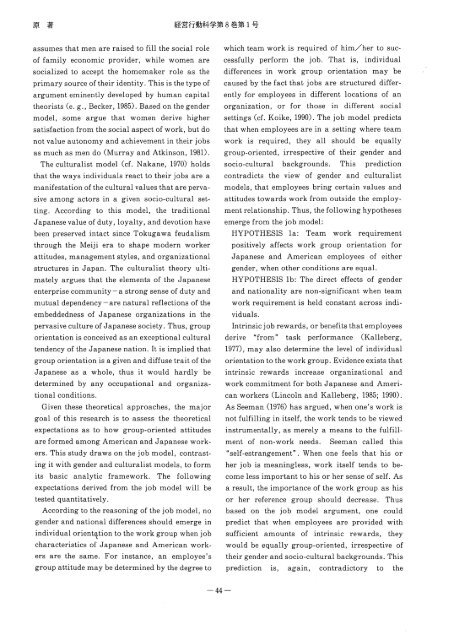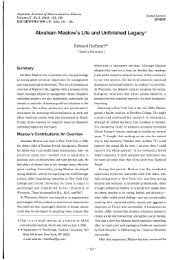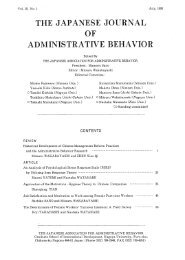Work Group Orientation of Industrial Workers: A Japan-U.S. Gender ...
Work Group Orientation of Industrial Workers: A Japan-U.S. Gender ...
Work Group Orientation of Industrial Workers: A Japan-U.S. Gender ...
Create successful ePaper yourself
Turn your PDF publications into a flip-book with our unique Google optimized e-Paper software.
mnmn^msmmm<br />
assumes that men are raised to fill the social role<br />
<strong>of</strong> family economic provider, while women are<br />
socialized to accept the homemaker role as the<br />
primary source <strong>of</strong> their identity. This is the type <strong>of</strong><br />
argument eminently developed by human capital<br />
theorists (e. g., Becker, 1985). Based on the gender<br />
model, some argue that women derive higher<br />
satisfaction from the social aspect <strong>of</strong> work, but do<br />
not value autonomy and achievement in their jobs<br />
as much as men do (Murray and Atkinson, 1981).<br />
The culturalist model (cf. Nakane, 1970) holds<br />
that the ways individuals react to their jobs are a<br />
manifestation <strong>of</strong> the cultural values that are perva<br />
sive among actors in a given socio-cultural set<br />
ting. According to this model, the traditional<br />
<strong>Japan</strong>ese value <strong>of</strong> duty, loyalty, and devotion have<br />
been preserved intact since Tokugawa feudalism<br />
through the Meiji era to shape modern worker<br />
attitudes, management styles, and organizational<br />
structures in <strong>Japan</strong>. The culturalist theory ulti<br />
mately argues that the elements <strong>of</strong> the <strong>Japan</strong>ese<br />
enterprise community —a strong sense <strong>of</strong> duty and<br />
mutual dependency —are natural reflections <strong>of</strong> the<br />
embeddedness <strong>of</strong> <strong>Japan</strong>ese organizations in the<br />
pervasive culture <strong>of</strong> <strong>Japan</strong>ese society. Thus, group<br />
orientation is conceived as an exceptional cultural<br />
tendency <strong>of</strong> the <strong>Japan</strong>ese nation. It is implied that<br />
group orientation is a given and diffuse trait <strong>of</strong> the<br />
<strong>Japan</strong>ese as a whole, thus it would hardly be<br />
determined by any occupational and organiza<br />
tional conditions.<br />
Given these theoretical approaches, the major<br />
goal <strong>of</strong> this research is to assess the theoretical<br />
expectations as to how group-oriented attitudes<br />
are formed among American and <strong>Japan</strong>ese work<br />
ers. This study draws on the job model, contrast<br />
ing it with gender and culturalist models, to form<br />
its basic analytic framework. The following<br />
expectations derived from the job model will be<br />
tested quantitatively.<br />
According to the reasoning <strong>of</strong> the job model, no<br />
gender and national differences should emerge in<br />
individual orientation to the work group when job<br />
characteristics <strong>of</strong> <strong>Japan</strong>ese and American work<br />
ers are the same. For instance, an employee's<br />
group attitude may be determined by the degree to<br />
which team work is required <strong>of</strong> him/her to suc<br />
cessfully perform the job. That is, individual<br />
differences in work group orientation may be<br />
caused by the fact that jobs are structured differ<br />
ently for employees in different locations <strong>of</strong> an<br />
organization, or for those in different social<br />
settings (cf. Koike, 1990). The job model predicts<br />
that when employees are in a setting where team<br />
work is required, they all should be equally<br />
group-oriented, irrespective <strong>of</strong> their gender and<br />
socio-cultural backgrounds. This prediction<br />
contradicts the view <strong>of</strong> gender and culturalist<br />
models, that employees bring certain values and<br />
attitudes towards work from outside the employ<br />
ment relationship. Thus, the following hypotheses<br />
emerge from the job model:<br />
HYPOTHESIS la: Team work requirement<br />
positively affects work group orientation for<br />
<strong>Japan</strong>ese and American employees <strong>of</strong> either<br />
gender, when other conditions are equal.<br />
HYPOTHESIS lb: The direct effects <strong>of</strong> gender<br />
and nationality are non-significant when team<br />
work requirement is held constant across indi<br />
viduals.<br />
Intrinsic job rewards, or benefits that employees<br />
derive "from" task performance (Kalleberg,<br />
1977), may also determine the level <strong>of</strong> individual<br />
orientation to the work group. Evidence exists that<br />
intrinsic rewards increase organizational and<br />
work commitment for both <strong>Japan</strong>ese and Ameri<br />
can workers (Lincoln and Kalleberg, 1985; 1990).<br />
As Seeman (1976) has argued, when one's work is<br />
not fulfilling in itself, the work tends to be viewed<br />
instrumentally, as merely a means to the fulfill<br />
ment <strong>of</strong> non-work needs. Seeman called this<br />
"self-estrangement". When one feels that his or<br />
her job is meaningless, work itself tends to be<br />
come less important to his or her sense <strong>of</strong> self. As<br />
a result, the importance <strong>of</strong> the work group as his<br />
or her reference group should decrease. Thus<br />
based on the job model argument, one could<br />
predict that when employees are provided with<br />
sufficient amounts <strong>of</strong> intrinsic rewards, they<br />
would be equally group-oriented, irrespective <strong>of</strong><br />
their gender and socio-cultural backgrounds. This<br />
prediction is, again, contradictory to the<br />
-44-




